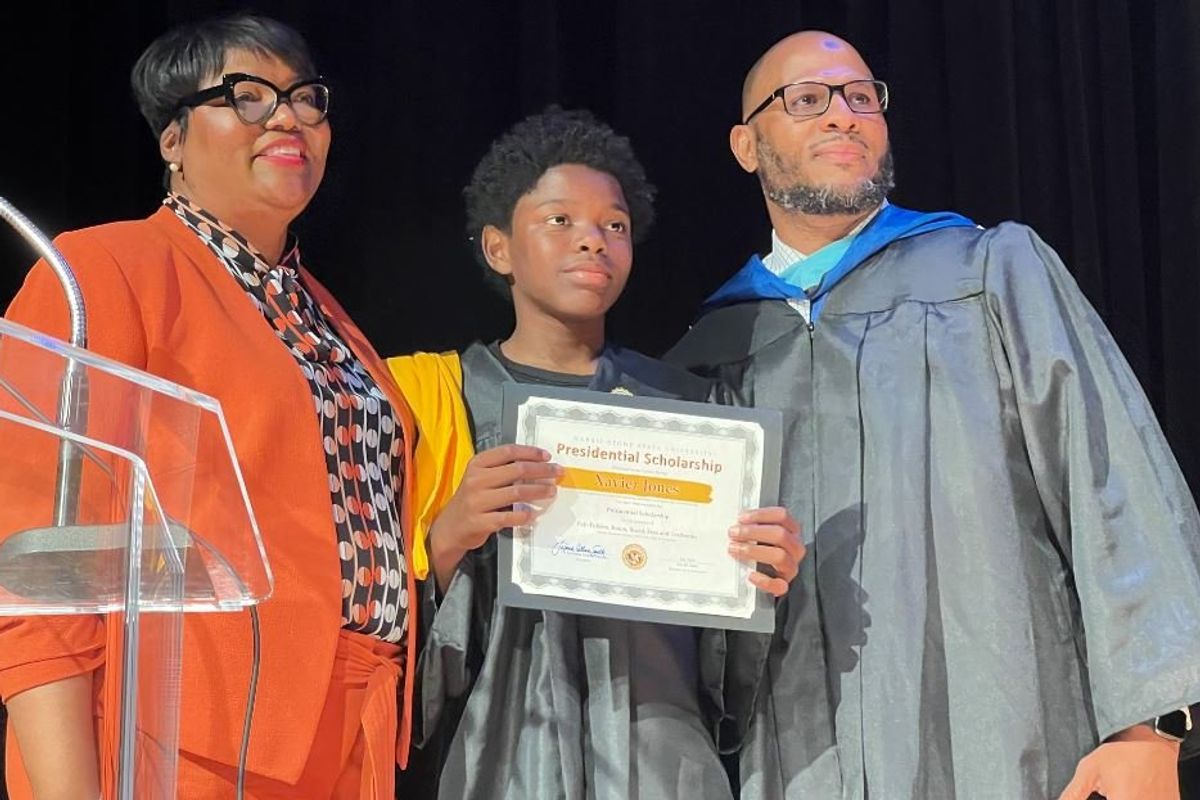Teen who walked 6 miles to his 8th-grade graduation awarded a full-ride college scholarship
"Even on your worst day, keep pressing forward.”

Xavier Jones is given his scholarship to Harris-Stowe Stete University in St. Louis.
A story out of St. Louis shows how some students have to overcome many more barriers than others on their road to success. But in this student's case, people in important positions recognized his perseverance and rewarded him in a way that could make his future less of a struggle.
According to a report from KAKE, 14-year-old Xavier Jones had no ride to his 8th-grade graduation ceremony, so he walked six miles to pick up his diploma.
“I was going to tell an adult, but my grandpa’s car was down. So I was just going to walk there,” he told KAKE.
Jones was graduating from Yeatman Middle School, but the ceremony was held at Harris-Stowe State University, a public historically-Black university in St. Louis.
“I looked up Harris-Stowe University on Google Maps and then I saw the walking distance and then I said I could probably make it,” Xavier told KAKE. “I wanted to walk across the stage.”
Knowing it would be a long walk, he brought along his brother and friend for the journey. To get from his home in West Florissant to Harris-Stowe State University took them two and a half hours.
Darren Seals, Jones’ mentor, called attention to the student's incredible dedication during a speech at the ceremony.
“I had to stop my speech and call him on board and was like, ‘Hey, everybody get off your feet and give him a standing ovation,'” Seals told Fox 2. “They clapped for him. They were like, ‘Woah, this boy walked.'”
Jones’ journey also caught the attention of Dr. Latonia Collins Smith, the president of Harris-Stowe State University, who was impressed by his determination.
“When I heard that story and to see that young man who was so bright and excited and driven,” President Collins Smith said. “It spoke volumes to me. It spoke resilience, persistence, perseverance. Regardless of what the adversity is, I’m going to press my way to this promotion ceremony. So that is what sparked my interest in saying, ‘Hey, this is the type of kid that we want to recruit to Harris-Stowe.”
President Collins Smith sees Jones as an example of the many barriers that students in the area face to getting an education. “Many of our students come with a story and many of our students come with environmental barriers they have overcome or that they are currently overcoming,” President Collins Smith told KAKE.
To reward his incredible dedication, the school gave him a full-ride scholarship for when he graduates high school. The scholarship includes four years of tuition, books and student fees.
When Jones heard he got a “free ride” to college, he thought it meant transportation. When Seals explained it was a scholarship, Jones couldn’t believe it. “Wait a minute, I don’t have to pay for college?” he asked Seals.
Jones hopes he can be a NASCAR driver after he graduates college.
“At the end of the rainbow, there’s a pot of gold. I learned a lot from Xavier that day," says President Collins Smith. "Even on your worst day, keep pressing forward.”
- Her mom was helping pay off her student loans. When she passed away, the debt had doubled. ›
- Free college is becoming a reality across America as 30th state is set to pass funding bill ›
- High school student recieves record $9M in scholarship offers from ... ›
- 7th graders guess what 30-year-olds want for Christmas - Upworthy ›
- She fell in love with endangered porpoises at age 7. Now, she's on a mission to save the ocean. ›

